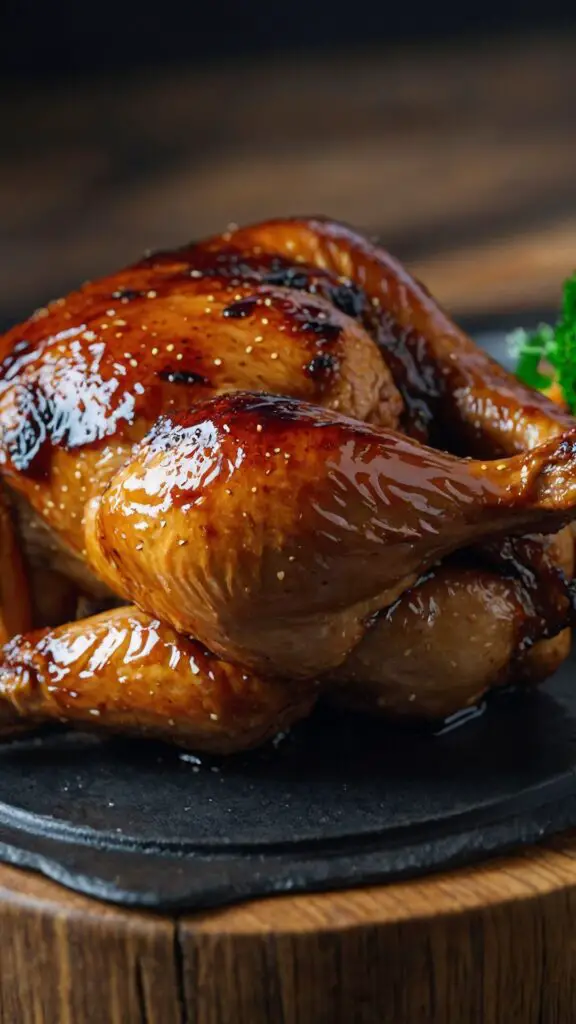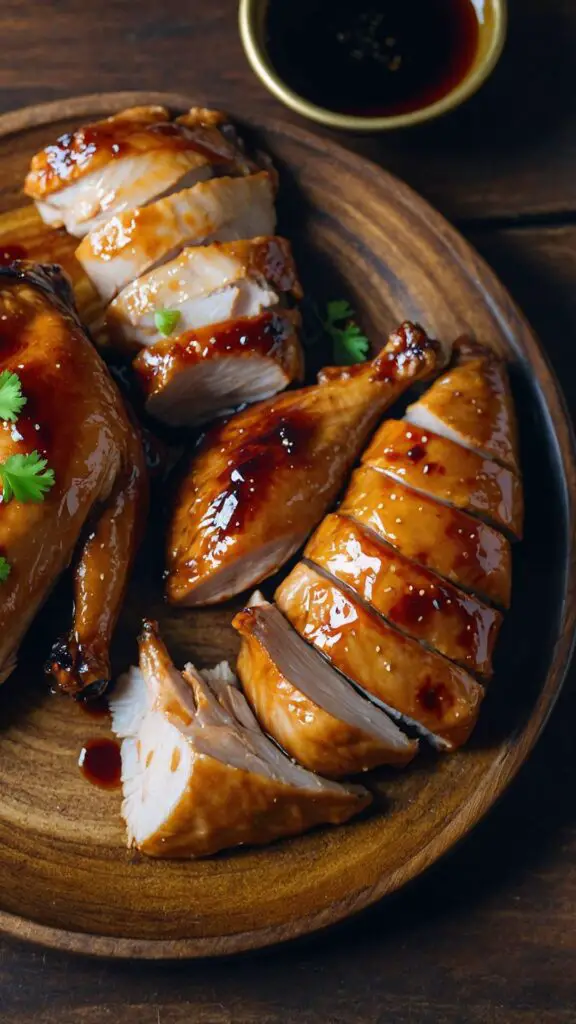Soy Sauce Chicken – Culinary Chase
Before diving into the savory world of soy sauce chicken, let’s chat about what brings out the dish’s intense flavor. While soy sauce chicken is a star on its own, it plays well with various sides and drinks. Here’s what you can pair with it:
Steamed Jasmine Rice: The fluffy texture of jasmine rice balances the salty umami flavors of the chicken. Every bite of sauce-soaked rice just sings on your palate.
Stir-Fried Bok Choy: The slight bitterness of bok choy adds depth. Toss it with garlic for a delightful crunch and color on your plate.
Pickled Vegetables: Adding some zing, pickled radishes or cucumbers cut through the richness. Their acidity complements the deep flavors of the soy sauce chicken.
Chinese Tea: A warming cup of jasmine or oolong tea enhances the meal perfectly. This pairing isn’t just about taste; it creates a full dining experience.

Let me take you on a journey through the kitchen, where a humble chicken transforms into a dish bursting with flavor and tradition. Growing up, soy sauce chicken was a staple at family gatherings. Each bite was a reminder of home. This recipe combines cultural history with mouthwatering goodness. It’s manageable for a weeknight dinner or impressive enough for guests. Are you ready to become a soy sauce chicken aficionado?
What is Soy Sauce Chicken?
Soy sauce chicken, or “Soy Sauce Braised Chicken,” is a classic dish from Chinese cuisine. It involves marinating pieces of chicken in a savory soy sauce mixture, which creates a rich color and intense flavor. Traditionally served warm or at room temperature, this dish often features glossy skin and juicy meat—a testament to the slow cooking process.
Well-prepared soy sauce chicken generally has a slightly sweet, salty, and umami flavor profile, creating a harmonious blend. The depth of flavor in this dish isn’t just delightful; it tells a story of Chinese culinary expertise passed down through generations.
What Does It Taste Like?
Picture this: You take a bite of juicy chicken, and the flavors explode. The soy sauce brings salty notes while the sugar adds a touch of sweetness. Ginger and garlic intertwine, offering warmth. If cooked properly, the skin should be tender yet slightly crisp, providing an enticing texture contrast. It’s a dish that wraps you in comfort with every mouthful, evoking memories of cozy family dinners and communal feasts.
You will also like the following Lunch and Dinner recipes!
Why This Recipe Works?
When I set out to create this soy sauce chicken recipe, I aimed for an approach that was both simple and effective. Here are a few reasons that make this recipe shine:
1. Balanced Flavors: The combination of light and dark soy sauce, alongside sugar and wine, creates a rich vehicle of flavor. This interplay ensures that each bite delivers depth and satisfaction.
2. Effortless Preparation: With relatively few steps, this recipe is straightforward. Whether you’re a beginner or an expert, you’ll find an ease in preparing this dish, making it achievable any day of the week.
3. Versatile Leftovers: Leftovers mean different ideas for meals! Throw some chopped soy sauce chicken into fried rice or on a salad for lunch. It garners its unique flavor whether hot or cold.
4. Cultural Tradition: Cooking soy sauce chicken connects us to centuries of culinary practice. You’re not just following a recipe; you’re participating in a tradition cherished by countless families.
Ingredients for Soy Sauce Chicken
Now that you’re thrilled about making this chicken, let’s gather our materials. Here’s what you need:
1 whole chicken (around 4 pounds; preferably organic, free-range, and never frozen)
10 cups filtered water
1 ½ cups naturally brewed soy sauce
1 ¼ cups dark soy sauce
1 ½ cups Chinese rose wine (Mei Gui Lu) or Shaoxing rice wine
1 cup granulated sugar (plus 2 tablespoons for balance)
2 teaspoons fine sea salt
2 teaspoons neutral cooking oil
7 slices fresh ginger root
2 scallions, cut into 3-inch sections and lightly smashed
3 whole star anise pods
1 small cinnamon stick
2 cloves garlic, lightly crushed

Step-by-Step Instructions
Ready to jump into the cooking part? Let’s break it down step by step.
Step 1: Prepare the Chicken
Start by rinsing the chicken thoroughly under cold water. Remove any giblets that may be inside the cavity. Pat the chicken dry with paper towels. This helps the skin crisp up nicely during cooking.
Step 2: Make the Marinade
In a large bowl, combine the light soy sauce, dark soy sauce, rose wine, sugar, and salt. Stir until the sugar dissolves completely. This mixture will serve as both a marinade and a cooking broth.
Step 3: Marinate
Place the chicken in a large resealable bag or container. Pour the marinade over it, ensuring the chicken is fully immersed. Seal the bag or cover the container. Refrigerate for at least 2 hours, but overnight is best for maximizing flavor.
Step 4: Prepare for Cooking
When ready to cook, remove the chicken from the refrigerator and let it sit at room temperature for about 30 minutes. This helps it cook evenly.
Step 5: Heat the Oil
In a large pot, add the neutral cooking oil and heat it over medium-high. Once it’s hot, add the ginger, scallions, star anise, cinnamon stick, and garlic. Sauté until fragrant—this should take about a minute.
Step 6: Brown the Chicken
Next, place the marinated chicken into the pot, skin side down. Sear on medium heat for about 5 minutes, allowing the skin to develop a golden-brown color. Flip it over gently using tongs.
Step 7: Add the Liquid
Carefully pour in the marinade. This gives the chicken a flavorful braising liquid as it cooks. Cover the pot and reduce the heat to low. Let it simmer for about 40-50 minutes.
Step 8: Check for Doneness
Check that the chicken has reached an internal temperature of 165°F (74°C). If it’s not there yet, reduce the heat slightly and let it cook a little longer.
Step 9: Rest the Chicken
Once cooked, remove the chicken and let it rest for 10 minutes. This preserves the juices and improves texture.
Step 10: Slice and Serve
Carve the chicken into pieces, drizzle a bit of sauce over it, and serve alongside rice or salad. Garnish with fresh scallions for a pop of color!
Notes
Here are a few tips to ensure your soy sauce chicken turns out perfect each time:
Quality Matters: Use high-quality soy sauce. The flavor of your chicken depends on it. Look for brands that are naturally brewed.
Don’t Skip the Resting Time: Allowing the chicken to rest before slicing helps it retain moisture. Believe me, it’s worth the wait!
Adjust Sweetness: If you prefer a sweeter flavor profile, just increase the sugar in your marinade slightly.
Braising Liquid: Save the braising liquid! It tastes incredible drizzled over rice or veggies.
Cooking Vessel: A heavy-bottom pot, like a Dutch oven, distributes heat evenly and keeps the moisture locked in.
Nutrition Information
For those keeping track, here’s what a serving of soy sauce chicken typically includes (based on an average 100g serving):
Calories: Approximately 200
Protein: 22g
Fat: 8g
Carbohydrates: 10g
Sugar: 3g
Sodium: 750mg

How To Store The Leftovers?
Leftovers can be a delight! Store any extra chicken in an airtight container in the refrigerator for up to 3 days. When reheating, do so gently on the stove or in the microwave to retain moisture. The flavors often intensify after sitting overnight, making tomorrow’s lunch a treat.
Sides for Soy Sauce Chicken
Looking for delicious sides? Here are a few suggestions that marry harmoniously with your soy sauce chicken:
1. Steamed Broccoli: The vibrant green color adds to your plate’s aesthetics. Simply steam the broccoli until tender and drizzle with sesame oil.
2. Fried Rice: Use leftover rice and toss it in a hot pan with peas, carrots, and egg. It absorbs the flavors of the chicken beautifully.
3. Cucumber Salad: A light salad of thinly sliced cucumbers, rice vinegar, and sesame seeds offers a refreshing crunch. This bursts with flavor and cuts through the richness.
4. Egg Noodles: Toss some egg noodles in a light soy and sesame sauce. They complement the chicken while also absorbing those amazing flavors.
Alternative Choices to Ingredients
Sometimes, ingredients are hard to come by. No worries! Here are alternatives to consider:
1. Soy Sauce: If you’re gluten-free, try tamari. It offers a similar flavor profile without gluten.
2. Chinese Rose Wine: You can substitute with dry sherry or even a splash of rice vinegar mixed with water if you’re in a pinch.
3. Sugar: Honey or maple syrup can work in a pinch if you’re out of granulated sugar.
4. Whole Chicken: Chicken thighs or legs can replace the whole chicken. Just adjust cooking time accordingly, as smaller pieces cook faster.

Soy Sauce Chicken
Equipment
- Bowl
Ingredients
- 1 whole chicken around 4 pounds; preferably organic, free-range, and never frozen
- 10 cups filtered water
- 1 ½ cups naturally brewed soy sauce
- 1 ¼ cups dark soy sauce
- 1 ½ cups Chinese rose wine Mei Gui Lu or Shaoxing rice wine
- 1 cup granulated sugar plus 2 tablespoons for balance
- 2 teaspoons fine sea salt
- 2 teaspoons neutral cooking oil
- 7 slices fresh ginger root
- 2 scallions cut into 3-inch sections and lightly smashed
- 3 whole star anise pods
- 1 small cinnamon stick
- 2 cloves garlic lightly crushed
Instructions
Step 1: Prepare the Chicken
- Start by rinsing the chicken thoroughly under cold water. Remove any giblets that may be inside the cavity. Pat the chicken dry with paper towels. This helps the skin crisp up nicely during cooking.
Step 2: Make the Marinade
- In a large bowl, combine the light soy sauce, dark soy sauce, rose wine, sugar, and salt. Stir until the sugar dissolves completely. This mixture will serve as both a marinade and a cooking broth.
Step 3: Marinate
- Place the chicken in a large resealable bag or container. Pour the marinade over it, ensuring the chicken is fully immersed. Seal the bag or cover the container. Refrigerate for at least 2 hours, but overnight is best for maximizing flavor.
Step 4: Prepare for Cooking
- When ready to cook, remove the chicken from the refrigerator and let it sit at room temperature for about 30 minutes. This helps it cook evenly.
Step 5: Heat the Oil
- In a large pot, add the neutral cooking oil and heat it over medium-high. Once it’s hot, add the ginger, scallions, star anise, cinnamon stick, and garlic. Sauté until fragrant—this should take about a minute.
Step 6: Brown the Chicken
- Next, place the marinated chicken into the pot, skin side down. Sear on medium heat for about 5 minutes, allowing the skin to develop a golden-brown color. Flip it over gently using tongs.
Step 7: Add the Liquid
- Carefully pour in the marinade. This gives the chicken a flavorful braising liquid as it cooks. Cover the pot and reduce the heat to low. Let it simmer for about 40-50 minutes.
Step 8: Check for Doneness
- Check that the chicken has reached an internal temperature of 165°F (74°C). If it’s not there yet, reduce the heat slightly and let it cook a little longer.
Step 9: Rest the Chicken
- Once cooked, remove the chicken and let it rest for 10 minutes. This preserves the juices and improves texture.
Step 10: Slice and Serve
- Carve the chicken into pieces, drizzle a bit of sauce over it, and serve alongside rice or salad. Garnish with fresh scallions for a pop of color!
Notes
- Quality Matters: Use high-quality soy sauce. The flavor of your chicken depends on it. Look for brands that are naturally brewed.
- Don’t Skip the Resting Time: Allowing the chicken to rest before slicing helps it retain moisture. Believe me, it’s worth the wait!
- Adjust Sweetness: If you prefer a sweeter flavor profile, just increase the sugar in your marinade slightly.
- Braising Liquid: Save the braising liquid! It tastes incredible drizzled over rice or veggies.
- Cooking Vessel: A heavy-bottom pot, like a Dutch oven, distributes heat evenly and keeps the moisture locked in.
Nutrition
Frequently Asked Questions
1. Can I use frozen chicken for this recipe?
While it’s best to use fresh chicken for optimal texture, you can use thawed frozen chicken. Just ensure it’s completely thawed and dried before marinating.
2. How long should I marinate the chicken?
A minimum of 2 hours is recommended. However, overnight yields even better flavor.
3. Can I make this dish in advance?
Absolutely! Soy sauce chicken tastes even better the next day. Store it properly and reheat it gently for best results.
4. How can I make this recipe spicier?
If you love heat, add sliced chilies to the marinade or toss in some chili paste for a spicy kick.
Conclusion
Soy sauce chicken might seem simple at first glance, but it’s loaded with flavor, history, and adaptability. Whether you’re serving it for a family dinner or a gathering of friends, this dish will impress. Each bite is a celebration of culinary tradition and a connection to family memories.
So grab your apron and dive into the world of soy sauce chicken! You’ll soon be dishing out plates that sing with flavor and warmth. Happy cooking!
